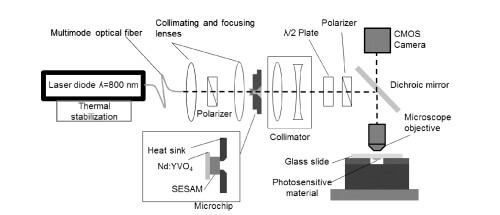Laser additive manufacturing technology is growing more prevalent around the world for industrial uses, leading researchers to investigate further in relation to polymerization, with findings outlined in the recently published ‘High-speed two-photon polymerization 3D printing with a microchip laser at its fundamental wavelength.’
As sub-micrometer resolution offers ‘unmatched’ potential via laser technology today, the researchers state that spatial resolution down to 100 nm is possible with two-photon polymerization (2PP) technology. In this study, they discovered that using a Q-switched microchip laser improved both quality and performance remarkably:
“Thanks to the laser performance and high 2PP reactivity of the prepared photoresist directly at the fundamental wavelength of our microchip laser, 2PP 3D printing speeds of up to 20 mm/s are demonstrated and objects with feature sizes down to 250 nm are produced,” states the research team. “These 2PP 3D printing characteristics are on par with femtosecond lasers.”

The structure of the photoinitiator (a). Single photon absorption spectrum of the photoinitiator (in dichloromethane) (b). Absorption spectrum in the vicinity of laser wavelength is shown in the inset (in acetone).
The following speeds were investigated in the range of 0.1 mm/s to 20 mm/s and laser power in the average range of 5 mW to 30 mW, with researchers discovering the following:
- Low scanning speed or high laser power cause damage because of overexposure
- Underexposure leads to unstable structures that are washed out during development
- Structuring window spans as far as 20 mm/s, limited by laser power
- Using laser speed close to the polymerization threshold offers smallest feature size (about 250 nm)
Polymerization was also attempted as they refrained from adding the photo-initiator, resulting in no microstructures at all, demonstrating that (thermal) polymerization was impossible within the confines of the experiment; however, two-photon absorption was a central polymerization mechanism.

SEM images of 3D woodpile structures fabricated by the SESAM Q-switched microchip laser: (a) – average laser power of 17 mW and scanning speed of 0.6 mm/s; (b) – average laser power of 27 mW and scanning speed of 19 mm/s.

SEM images of 3D woodpile structures demonstrating the ultimate achieved feature size and fabrication speed: (a), (b) – woodpile structure fabricated with average laser power of 14 mW and scanning speed of 5 mm/s; (c), (d) – woodpile structure fabricated with average laser power of 27 mW and scanning speed of 20 mm/s.
In using lower NA, the researchers found narrow and tall rods, with top layer polymeric rods flexing sideways due to the achieved high aspect ratio.
“In order to investigate the achievable feature sizes, widths of the polymeric rods forming the woodpile structures obtained at different scanning speeds and laser powers were measured,” explained the researchers. “These measurements were carried out using magnified SEM images of the woodpiles.
“Both the feature sizes and polymerization speeds are on a par with 2PP fabrication by femtosecond lasers, with a significant reduction in the system footprint and cost,” concluded the researchers.
As researchers continue to expand the knowledge base of 3D printing and the ever-growing library of suitable materials for fabrication, polymerization has been studied over the years in many forms and for many different applications, from the nanoscale to use in atomic force microscopy, to microrobot production.
What do you think of this news? Let us know your thoughts! Join the discussion of this and other 3D printing topics at 3DPrintBoard.com.
[Source / Images: ‘High-speed two-photon polymerization 3D printing with a microchip laser at its fundamental wavelength’]
Subscribe to Our Email Newsletter
Stay up-to-date on all the latest news from the 3D printing industry and receive information and offers from third party vendors.
You May Also Like
Precision at the Microscale: UK Researchers Advance Medical Devices with BMF’s 3D Printing Tech
University of Nottingham researchers are using Boston Micro Fabrication‘s (BMF) 3D printing technology to develop medical devices that improve compatibility with human tissue. Funded by a UK grant, this project...
3D Printing Webinar and Event Roundup: April 21, 2024
It’s another busy week of webinars and events, starting with Hannover Messe in Germany and continuing with Metalcasting Congress, Chinaplas, TechBlick’s Innovation Festival, and more. Stratasys continues its advanced training...
3D Printing Webinar and Event Roundup: March 17, 2024
It’s another busy week of webinars and events, including SALMED 2024 and AM Forum in Berlin. Stratasys continues its in-person training and is offering two webinars, ASTM is holding a...
3D Printed Micro Antenna is 15% Smaller and 6X Lighter
Horizon Microtechnologies has achieved success in creating a high-frequency D-Band horn antenna through micro 3D printing. However, this achievement did not rely solely on 3D printing; it involved a combination...






























